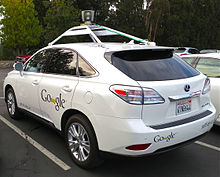Google driverless car
From Wikipedia, the free encyclopedia
Not to be confused with Google Drive or GMail Drive.
The U.S. state of Nevada passed a law on June 29, 2011 permitting the operation of autonomous cars in Nevada. Google had been lobbying for robotic car laws.[5][6][7] The Nevada law went into effect on March 1, 2012, and the Nevada Department of Motor Vehicles issued the first license for an autonomous car in May 2012. The license was issued to a Toyota Prius modified with Google's experimental driverless technology.[8] As of April 2012, Florida became the second state to allow the testing of autonomous cars on public roads.[9] California became the third state to legalize the use of self-driven cars for testing purposes as of September 2012 when Governor Jerry Brown signed the bill into law at Google HQ in Mountain View.[10] Governor Rick Snyder signed legislation allowing the testing of automated or self-driving vehicles on Michigan’s roads in December 2013, but requires a human in the driver seat at all time while the vehicle is in use.[11]
Contents
Technology
Google's robotic cars have about $150,000 in equipment including a $70,000 LIDAR (laser radar) system.[12] The range finder mounted on the top is a Velodyne 64-beam laser. This laser allows the vehicle to generate a detailed 3D map of its environment. The car then takes these generated maps and combines them with high-resolution maps of the world, producing different types of data models that allow it to drive itself.[13]Road testing

Lexus RX450h retrofitted as a Google driverless car
On March 28, 2012, Google posted a YouTube video showing Steve Mahan, a Morgan Hill California resident, being taken on a ride in its self-driving Toyota Prius. In the video, Mahan states "Ninety-five percent of my vision is gone, I'm well past legally blind". In the description of the YouTube video, it is noted that the carefully programmed route takes him from his home to a drive-through restaurant, then to the dry cleaning shop, and finally back home.[16][17]
In August 2012, the team announced that they have completed over 300,000 autonomous-driving miles (500 000 km) accident-free, typically have about a dozen cars on the road at any given time, and are starting to test them with single drivers instead of in pairs.[18] Four U.S. states have passed laws permitting autonomous cars as of December 2013: Nevada, Florida, California, and Michigan.[19] A law proposed in Texas would establish criteria for allowing "autonomous motor vehicles".[20][21]
Incidents
In August 2011, a human-controlled Google driverless car was involved in a crash near Google headquarters in Mountain View, CA. Google has stated that the car was being driven manually at the time of the accident.[22] A previous incident involved a Google driverless car being rear-ended while stopped at a traffic light.[23] Google say's that neither of these incidents were the fault of Google's car but the fault of other humans operating the car.Commercialization
While Google had no immediate plans to commercially develop the system, the company hopes to develop a business which would market the system and the data behind it to automobile manufacturers. An attorney for the California Department of Motor Vehicles raised concerns that "The technology is ahead of the law in many areas," citing state laws that "all presume to have a human being operating the vehicle".[3] According to The New York Times, policy makers and regulators have argued that new laws will be required if driverless vehicles are to become a reality because "the technology is now advancing so quickly that it is in danger of outstripping existing law, some of which dates back to the era of horse-drawn carriages".[7]Google lobbied for two bills that made Nevada the first state where autonomous vehicles can be legally operated on public roads. The first bill is an amendment to an electric vehicle bill that provides for the licensing and testing of autonomous vehicles. The second bill will provide an exemption from the ban on distracted driving to permit occupants to send text messages while sitting behind the wheel. The two bills came to a vote before the Nevada state legislature’s session ended in June 2011. It has been speculated that Nevada was selected due to the Las Vegas Auto Show and the Consumer Electronics Show, and the high likelihood that Google will present the first commercially viable product at either or both of these events. Google executives, however, refused to state the precise reason they chose Nevada to be the maiden state for the autonomous car.[7]
Nevada passed a law in June 2011 concerning the operation of autonomous cars in Nevada,[5][6][7] which went into effect on March 1, 2012.[8] A Toyota Prius modified with Google's experimental driverless technology was licensed by the Nevada Department of Motor Vehicles (DMV) in May 2012. This was the first license issue in the United States for a self-driven car.[8] License plates issued in Nevada for autonomous cars will have a red background and feature an infinity symbol (∞) on the left side because, according to the DMV Director, "...using the infinity symbol was the best way to represent the 'car of the future'." [15] Nevada's regulations require a person behind the wheel and one in the passenger’s seat during tests.
In August 2013 news reports surfaced about Robo-Taxi, a driverless vehicle from Google.[24] These reports re-appeared again in early 2014.[25] following the granting of a patent to Google for an advertising fee funded transportation service which included autonomous vehicles as a method of transport.[26]




0 comments:
Post a Comment